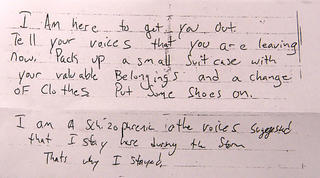An anonymous blog reader
submitted the following comment. Because it is fairly typical of some common misconceptions about assisted treatment and our organization, we want to take a moment to respond.
Blogtac reader: Although these tragedies are certainly horrific, I am alarmed that your organization seeks to use them as justification for forced drugging.
TAC: Assisted outpatient treatment is not the same as forced drugging. It is court-ordered treatment that relies on individuals to comply with treatment orders. The majority of people who refuse medication subsequently
agree to take it in oral form when informed that they must. “Forced drugging” is a phrase used by those who oppose AOT to scare people into believing that people under orders will be held down and injected. This is not the case. [
Read a prior response to a reader on this topic.]
Blogtac reader: Only a very small percentage of the mentally ill are violent and, as yet, there is no reliable way to determine which people will become violent.
TAC: People with severe mental illnesses who are taking medication are no more likely to be violent than the general public. But failure to take medication is one of the
top three predictors of violence. Every person with a mental illness is not, of course,
violent, but those who are make national headlines, increasing the
stigma on the large majority who are not.
Blogtac reader: In addition, many of the violent mentally ill *are* actively seeking help and being turned away before they commit these monstrous acts. This was certainly the case with the gentleman in New York whose crime prompted Kendra's Law.
TAC: In the two years prior to pushing Kendra Webdale to her death in front of a New York City subway train, Andrew Goldstein received 199 days of inpatient and emergency room services, on 15 different occasions, in six different hospitals from1997 to 1999. Four different clinics provided outpatient services in this time period. This is hardly the profile of a patient who was refused services - it was Goldstein who often
refused treatment.
Interestingly enough, one of the many positive outcomes of the law enacted after this tragedy is that it has
reduced harmful behavior for participants (47 percent fewer physically harmed others).
Blogtac reader: Your remedy (which appears to be force drugging everybody with a psych label) is worse than the problem you are trying to solve. I really hope you reconsider and give a little more thought to civil liberties.
The remedy is to save people’s lives by getting them help before they deteriorate to suicide or homicide or become a victim of violence.
In terms of who AOT affects, it is specifically and carefully designed only for the sickest of the sick, those who are incapable of maintaining their own treatment or making informed decisions concerning it. For instance, Kendra’s Law is used on less than ½ of 1 percent of all the people with bipolar or schizophrenia in the state. [Completely opposite of the
prediction of the opposition five years earlier, which may be where you are getting this concept that everybody with a mental illness would be affected ...]
As to civil liberties, don’t take our word for it. Read this essay by the board of directors of the B.C. Civil Liberties Association,
“Far from respecting civil liberties, legal obstacles to treating the mentally ill limit or destroy the liberty of the person.” Or some perspectives of
consumers (and
research on their perspectives) who have actually experienced AOT. Or
voices of those who have seen how their lives were saved.
Thanks for the questions.
Labels: Andrew Goldstein, civil liberties, consumer perspective, Kendra's Law, violence





